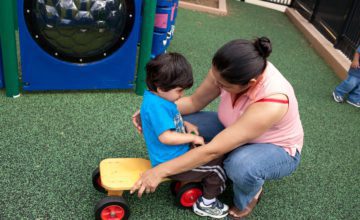These parent-child activities support the child's physical and social-emotional development through creative play ideas.
The Gather Round activities are designed to help families promote their child’s language and literacy skills, while also nurturing the other domains of development (thinking, language and communication, social-emotional, and physical skills). A children’s book is suggested for each topic area and age (birth to 12 months, 12-24 months, and 24 to 36 months) and activities related to the book based on a range of developmental domains and early skills. The activities can be used with parents as a tool to promote children’s learning through book-sharing and age-appropriate parent-child activities.
Birth to 12 Months
Book:
Snuggle Puppy by Sandra Boynton
Publisher: HMH Books
Activities that build on the ideas in Snuggle Puppy
1. This story has a song-like rhythmic beat, so let your baby make some noise! Give her two blocks or two small plastic bowls (ones that your baby can easily hold in each hand). Demonstrate how to bang them together and see if your baby is able to imitate you. Sing the Snuggle Puppy book or another song you like and bang your blocks together to make some “music.” Bringing objects together at midline, or the middle of your body, is a skill that helps babies coordinate the use of their hands.
2. This story shows a parent and child in an everyday routine—making cookies together. Snap some photos of you and your baby during an everyday routine: playing, taking a bath, getting ready for bed, eating dinner. Put these pictures together in a book for your child. Babies love looking at pictures of themselves and you. Sharing these photos shows your baby he is loved and special.
3. Snuggle Puppy shows lots of activities you can do with your little one as she grows: playing in the sand, dressing-up, jumping in leaves, and more. You might want to take a cue from the page where the parent sings, “OOO!” While holding your baby firmly, gently swing her in the air. Looking into her eyes, tell her: “Snuggle puppy of mine! Everything about you is especially fine!”
4. Singing to your baby is a fun addition to your baby’s everyday routines—and helps to build his understanding of spoken language. Choose a song you remember from your own childhood or one that is special to you in some way and make this song a part of your child’s daily routine. For example, you may sing to him right before you put him down for naps or bedtime. Soon, when your child hears this song he will learn “what happens next.” Before you know it, he may be moving his body to the song or babbling along with you.
5. Have fun with sounds when you are with your baby. “Talk” to your baby by saying, “oooooh!” like they do in story. Wait a moment and see if she moves her lips into an “o” and perhaps even says “ooo” back to you. As your baby begins to babble, you can respond to the sounds she is making, “Ma-ma-ma, ba-ba-ba, ga-ga-ga.” Babble “conversations” let your baby you are listening to her and that she is a good communicator.




